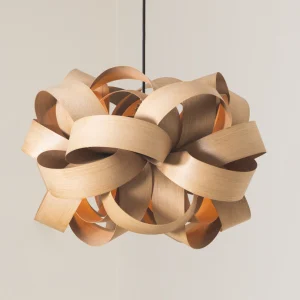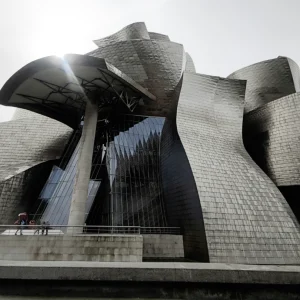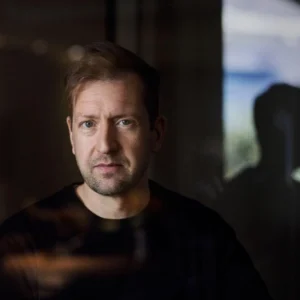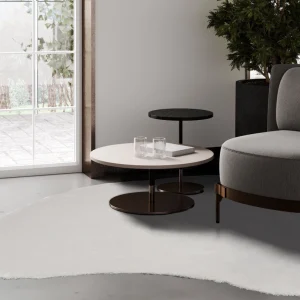YOU HAVE TO BE brave when refitting a landmark 20th-century civic space with an edgy, 21st-century eco aesthetic. If the principle of a true low-carbon retrofit is doing more with less – re-using walls, floors, doors, windows and fixtures – it could potentially lead to a somewhat flea-bitten aesthetic. But flea-bitten is definitely not the word that springs to mind entering the new Sustainable Workspaces foyer.
 There is a lot of salvaged and reclaimed furniture, including most of the freestanding chairs and tables, and many of the lights. Image Credit: Fred Howarth
There is a lot of salvaged and reclaimed furniture, including most of the freestanding chairs and tables, and many of the lights. Image Credit: Fred Howarth
It helps that we’re on the fifth floor of the landmark, Grade II listed County Hall, designed by architect Ralph Knott as the home of the London County Council (LCC), and opened in 1922 by George V. Luckily, ‘eco chic’ is the term that comes to mind for the pale, cork stools and timber-framed armchairs in the foyer, not to mention the acoustic panels made from mycelium that dangle from the exposed ceiling. The roughness of pre-loved parquet and chunks of visible brickwork where plaster has been removed could push it towards ruin-porn, but the smell of excellent coffee that emanates from the cafe/bar reassures, as does the quiet buzz of co-workers’ conversations, and the slew of hemp-toned logos that are scatter-gunned across one wall – presumably, all the eco tech start-ups that have been helped by the client, Sustainable Ventures (SV). A venture capitalist with a difference, SV supports promising tech start-ups working to resolve the climate emergency, with not just funding but flexible and affordable office space, which also helps to build the community. The words ‘Welcome to the home of climate tech’ over the reception desk reinforce the idea that this isn’t some toxic, fossil fuel-enriched corporate brand merely virtue-signalling with a few cork tiles and some salvaged lampshades. Dickon Hayward, founder and director of architects Material Works, praises his client for being willing to go the extra mile to really deliver on the low-carbon ambition.
The space itself is huge (3,600m2), and offers fantastic views onto the Houses of Parliament and the Thames along the north façade, and lots of daylight internally and externally, thanks to the floor plan that wraps around an open central courtyard. But when the client first showed Hayward the site, it was semi-derelict. ‘The windows were smashed, there was pigeon poo everywhere,’ he says.
 When the carbon footprint of the whole scheme was calculated, it was an estimated at 1,150t lower than a typical benchmark scheme. Image Credit: Jim Stephenson
When the carbon footprint of the whole scheme was calculated, it was an estimated at 1,150t lower than a typical benchmark scheme. Image Credit: Jim Stephenson
It was at this initial appraisal that the client told him: ‘We need to transform this into a sociable, lively workspace, it needs to be sustainable and there’s no money.’ There followed the inevitable discussion about the fact that materials that have a better carbon footprint are usually more expensive. But Hayward and his team got to thinking what could best be kept and what replaced. He says: ‘There are various things we can’t control – the envelope of the building. It’s a listed building. We needed to put services in, which we have done as efficiently as possible.’ The team drew on contacts within SV’s community to source innovative materials at more competitive prices. Says Hayward: ‘One of the companies in here is Mitsubishi’s sustainable innovation team, and so all the (services) kit came from them,’ (a hybrid system that has fewer refrigerants than a standard heating/cooling system). Next on the list was materials. As ever, it’s the largest areas that have the biggest impact on both carbon and budget. Says Hayward: ‘For a standard office fit-out in a space like this, you would be looking at a raised floor, suspended ceiling, plastering all the walls and painting everything.’ But there were more urgent necessities: replacing smashed windows, putting in bathroom facilities, providing power, heat and lighting. He says: ‘By the time we’d done that we’d practically blown the budget.’
So the original parquet floor – in all its bashed and battered glory – was retained. And it looks great; evidence of the life this building has had over the past century. There are many holes along the walls where old radiators have been ripped out, but they have been tidied round the edges, leaving exposed bricks and chunks of masonry for an aesthetic Hayward aptly describes as ‘raw’, ‘unmachined, natural’.
 Ceilings are left exposed and the walls unplastered. Image Credit: Fred Howarth
Ceilings are left exposed and the walls unplastered. Image Credit: Fred Howarth
Ceilings are exposed, with mottled acoustic panels made from mycelium (mushroom spores) provided by one of SV’s successful fledgelings, Biohm, which are also responsible for the curious, organic ‘worm cast’ panels on the reception planters (made from vegetable waste) and those on the bar (made from used coffee grounds).
There is a lot of salvaged and reclaimed furniture: most of the freestanding chairs and tables, many of the lights, most of the bathroom fittings including toilets. Doing it well – or knitting it into a coherent presentation – requires a unifying aesthetic (mid-century modern), and the strategic deployment of furniture in appropriate clusters rather than eclectic individual items. Larger pieces of bespoke furniture are made not from MDF but ‘ecoboard’ – ‘agricultural waste with nontoxic binders. Things like that per square metre are a bit more expensive than plywood,’ says Hayward, ‘but if you don’t do too much and focus it on small areas, you can make it work.’
Most of the partitions and meeting rooms in the co-working spaces are re-used components from an earlier scheme created for the client by modular specialists U-Build. Hayward shows me a cute twoperson meeting room, lined with a Dutch material made from repurposed textiles. These are insulated with a ‘wood wool’ product made by Biohm. Wherever innovative or sustainable products are used, the suppliers and the products are credited – such as the cork flooring in the event space, supplied by Quadrant, and the Paperstone kitchen counters.
‘Sourcing all of this and then persuading contractors they should install them, that takes a lot of time,’ says Hayward. ‘But when you’ve done it once you start to get these networks in place. The internet makes these things easier.’ A good source of materials and furniture was Salvo (salvoweb.com), an online portal for salvaged materials around the country.
When the carbon footprint of the whole scheme was calculated, it was an estimated at 1,150t lower than a typical benchmark scheme, (when measured over a full life cycle).
Equally important, the client has a great, light-filled co-working space that demonstrates its values – as well as the outputs of some of its talented offspring. On a bright, winter’s day there’s a great atmosphere as we tour the premises; sunshine pouring through large, listed windows caresses and illuminates all these rich and textured materials. My favourite touch were the window seats built into the north corner social space, looking out directly onto the Houses of Parliament. According to Hayward, he’s had great feedback from clients and tenants. And he’s hopeful that other office refurbs can take courage from this bold, lowcarbon case study. ‘Projects like this can be useful – they can push the debate a little.’





